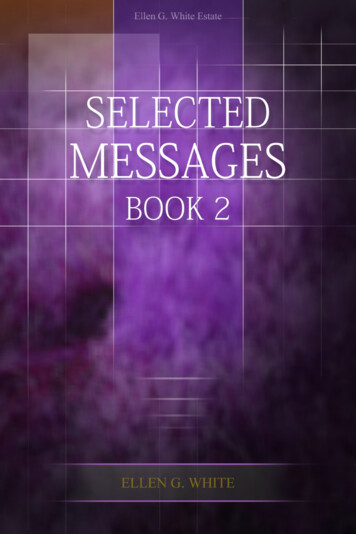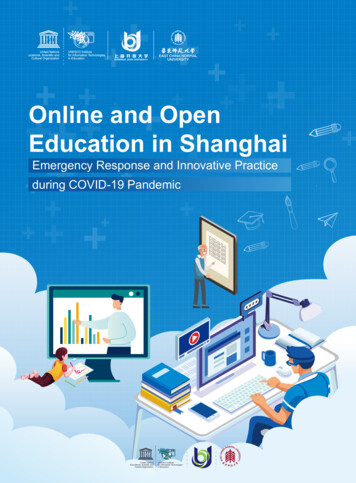
Transcription
EducationEllen G. White1903Copyright 2014Ellen G. White Estate, Inc.
Information about this BookOverviewThis eBook is provided by the Ellen G. White Estate. It is includedin the larger free Online Books collection on the Ellen G. WhiteEstate Web site.About the AuthorEllen G. White (1827-1915) is considered the most widely translatedAmerican author, her works having been published in more than 160languages. She wrote more than 100,000 pages on a wide variety ofspiritual and practical topics. Guided by the Holy Spirit, she exaltedJesus and pointed to the Scriptures as the basis of one’s faith.Further LinksA Brief Biography of Ellen G. WhiteAbout the Ellen G. White EstateEnd User License AgreementThe viewing, printing or downloading of this book grants you onlya limited, nonexclusive and nontransferable license for use solelyby you for your own personal use. This license does not permitrepublication, distribution, assignment, sublicense, sale, preparationof derivative works, or other use. Any unauthorized use of this bookterminates the license granted hereby.Further InformationFor more information about the author, publishers, or how youcan support this service, please contact the Ellen G. White Estateat mail@whiteestate.org. We are thankful for your interest andfeedback and wish you God’s blessing as you read.i
ForewordIt is rare, indeed, for a book devoted to the subject of educationto be read so widely or to endure so well the tests of changing timesas has the present work now appearing in this new, popular form.The fundamental principles clearly unfolded in this volume have formany decades made it the handbook of tens of thousands of parentsand teachers. Now, to further augment its already wide distributionand reading, it is published as one of the Christian Home Libraryvolumes, but without change in wording or paging.Every person must face the practical realities of life—its opportunities, its responsibilities, its defeats, and its successes. How he isto meet these experiences, whether he is to become master or victimof circumstances, depends largely upon his preparation to cope withthem—his education.True education is well defined as the harmonious developmentof all the faculties—a full and adequate preparation for this life andthe future eternal life. It is in the early years in the home and inthe formal schoolwork that the mind develops, a pattern of living isestablished, and character is formed.Keenly discerning the relative and lasting values of what constitutes true education in its broadest sense, the author of this bookpoints the way to their realization. An education in which the mentalfaculties are properly developed is clearly outlined. An educationin which the hands are skilled in useful trades is emphasized. Aneducation which recognizes God as the source of all wisdom and[8] understanding is earnestly recommended.The motivating objective of the author in her extensive writingsupon the subject of education was that youth on the threshold of lifemight be ready to take their place as good citizens, well preparedfor the practical experiences of living, fully developed physically,God-fearing, with characters untarnished and hearts true to principle.This volume is the paramount work in this group of writings in whichii
are set forth principles essential to the understanding of those whoguide the youth in the home and in the school.The writer of these pages was a friend of young men and women.She was for many years in close touch with institutions of learningand was well acquainted with the problems of youth in preparation for their lifework. Above all, she was endued with more thanordinary knowledge and skill as a writer and speaker.Concerned as it is with great guiding principles, and not with thedetails of curriculum or the merits of differing educational systems,the influence of this volume has been world wide, with editionspublished in a number of the leading languages of other continents.That this new American printing may still more widely disseminatethe great principles of character education is the ardent hope of thepublishers and—The Trustees of theEllen G. White Publications.[9]
ContentsInformation about this Book . . . . . . . . . . . . . . . . . . . . . . . . . . . . iForeword . . . . . . . . . . . . . . . . . . . . . . . . . . . . . . . . . . . . . . . . . . . iiFirst Principles . . . . . . . . . . . . . . . . . . . . . . . . . . . . . . . . . . . . . . . . . . 7Chapter 1—Source and Aim of True Education . . . . . . . . . . . . 8Chapter 2—The Eden School . . . . . . . . . . . . . . . . . . . . . . . . . 13Chapter 3—The Knowledge of Good and Evil . . . . . . . . . . . 15Chapter 4—Relation of Education to Redemption . . . . . . . . 19Illustrations . . . . . . . . . . . . . . . . . . . . . . . . . . . . . . . . . . . . . . . . . . 23Chapter 5—The Education of Israel . . . . . . . . . . . . . . . . . . . . 24Chapter 6—The Schools of the Prophets . . . . . . . . . . . . . . . . 33Chapter 7—Lives of Great Men . . . . . . . . . . . . . . . . . . . . . . . 38Daniel, an Ambassador of Heaven . . . . . . . . . . . . . . . . . . . 40True and Honest Men . . . . . . . . . . . . . . . . . . . . . . . . . . . . . . 42Elisha, Faithful in Little Things . . . . . . . . . . . . . . . . . . . . . . 43Moses, Powerful Through Faith . . . . . . . . . . . . . . . . . . . . . 45Paul, Joyful in Service . . . . . . . . . . . . . . . . . . . . . . . . . . . . . 48The Master Teacher . . . . . . . . . . . . . . . . . . . . . . . . . . . . . . . . . . . . 53Chapter 8—The Teacher Sent From God . . . . . . . . . . . . . . . . 54Chapter 9—An Illustration of His Methods . . . . . . . . . . . . . . 62The Transforming Power of Christ . . . . . . . . . . . . . . . . . . . 63From Weakness to Strength . . . . . . . . . . . . . . . . . . . . . . . . . 65A Lesson in Love . . . . . . . . . . . . . . . . . . . . . . . . . . . . . . . . . . 67Nature Teaching . . . . . . . . . . . . . . . . . . . . . . . . . . . . . . . . . . . . . . 73Chapter 10—God in Nature . . . . . . . . . . . . . . . . . . . . . . . . . . . 74Chapter 11—Lessons of Life . . . . . . . . . . . . . . . . . . . . . . . . . . . 77The Law of Ministry . . . . . . . . . . . . . . . . . . . . . . . . . . . . . . . 78Sowing in Faith . . . . . . . . . . . . . . . . . . . . . . . . . . . . . . . . . . . 78Life Through Death . . . . . . . . . . . . . . . . . . . . . . . . . . . . . . . 82Chapter 12—Other Object Lessons . . . . . . . . . . . . . . . . . . . . . 85The Message of the Stars . . . . . . . . . . . . . . . . . . . . . . . . . . . 86A Lesson of Trust . . . . . . . . . . . . . . . . . . . . . . . . . . . . . . . . . 88The Bible as an Educator . . . . . . . . . . . . . . . . . . . . . . . . . . . . . . . . 91Chapter 13—Mental and Spiritual Culture . . . . . . . . . . . . . . . 92Chapter 14—Science and the Bible . . . . . . . . . . . . . . . . . . . . . 96iv
ContentsChapter 15—Business Principles and Methods . . . . . . . . . .Honest Business Dealings . . . . . . . . . . . . . . . . . . . . . . . . .Chapter 16—Bible Biographies . . . . . . . . . . . . . . . . . . . . . . .By Faith to Conquest . . . . . . . . . . . . . . . . . . . . . . . . . . . . .The Discipline of Suffering . . . . . . . . . . . . . . . . . . . . . . . .The Testing of Job . . . . . . . . . . . . . . . . . . . . . . . . . . . . . . . .Chapter 17—Poetry and Song . . . . . . . . . . . . . . . . . . . . . . . .The Power of Song . . . . . . . . . . . . . . . . . . . . . . . . . . . . . . .Chapter 18—Mysteries of the Bible . . . . . . . . . . . . . . . . . . .Chapter 19—History and Prophecy . . . . . . . . . . . . . . . . . . . .Chapter 20—Bible Teaching and Study . . . . . . . . . . . . . . . .Physical Culture . . . . . . . . . . . . . . . . . . . . . . . . . . . . . . . . . . . . .Chapter 21—Study of Physiology . . . . . . . . . . . . . . . . . . . . .Chapter 22—Temperance and Dietetics . . . . . . . . . . . . . . . .Diet and Mental Development . . . . . . . . . . . . . . . . . . . . . .Chapter 23—Recreation . . . . . . . . . . . . . . . . . . . . . . . . . . . . .Chapter 24—Manual Training . . . . . . . . . . . . . . . . . . . . . . . .Character Building . . . . . . . . . . . . . . . . . . . . . . . . . . . . . . . . . . .Chapter 25—Education and Character . . . . . . . . . . . . . . . . .Chapter 26—Methods of Teaching . . . . . . . . . . . . . . . . . . . .Chapter 27—Deportment . . . . . . . . . . . . . . . . . . . . . . . . . . . .Chapter 28—Relation of Dress to Education . . . . . . . . . . . .Chapter 29—The Sabbath . . . . . . . . . . . . . . . . . . . . . . . . . . .Chapter 30—Faith and Prayer . . . . . . . . . . . . . . . . . . . . . . . .Chapter 31—The Lifework . . . . . . . . . . . . . . . . . . . . . . . . . .The Underteacher . . . . . . . . . . . . . . . . . . . . . . . . . . . . . . . . . . . .Chapter 32—Preparation . . . . . . . . . . . . . . . . . . . . . . . . . . . .Chapter 33—Co-operation . . . . . . . . . . . . . . . . . . . . . . . . . . .Chapter 34—Discipline . . . . . . . . . . . . . . . . . . . . . . . . . . . . .Meeting Life’s Discipline . . . . . . . . . . . . . . . . . . . . . . . . . .The Higher Course . . . . . . . . . . . . . . . . . . . . . . . . . . . . . . . . . . .Chapter 35—The School of the Hereafter . . . . . . . . . . . . . 166173174178185190193195202211212218221226229230
viEducation“We all, with unveiled face reflecting as a mirror the glory of theLord, are transformed into the same image from glory to glory.”[13]
First Principles
Chapter 1—Source and Aim of True Education“The knowledge of the holy is understanding; “Acquaint nowthyself with Him.”Our ideas of education take too narrow and too low a range.There is need of a broader scope, a higher aim. True educationmeans more than the pursual of a certain course of study. It meansmore than a preparation for the life that now is. It has to do withthe whole being, and with the whole period of existence possible toman. It is the harmonious development of the physical, the mental,and the spiritual powers. It prepares the student for the joy of servicein this world and for the higher joy of wider service in the world tocome.The source of such an education is brought to view in thesewords of Holy Writ, pointing to the Infinite One: In Him “are hidall the treasures of wisdom.” Colossians 2:3. “He hath counsel andunderstanding.” Job 12:13.The world has had its great teachers, men of giant intellect andextensive research, men whose utterances have stimulated thoughtand opened to view vast fields of knowledge; and these men havebeen honored as guides and benefactors of their race; but there is Onewho stands higher than they. We can trace the line of the world’s[14] teachers as far back as human records extend; but the Light wasbefore them. As the moon and the stars of our solar system shine bythe reflected light of the sun, so, as far as their teaching is true, do theworld’s great thinkers reflect the rays of the Sun of Righteousness.Every gleam of thought, every flash of the intellect, is from the Lightof the world.In these days much is said concerning the nature and importanceof “higher education.” The true “higher education” is that impartedby Him with whom “is wisdom and strength” (Job 12:13), out ofwhose mouth “cometh knowledge and understanding.” Proverbs 2:6.8
Chapter 1—Source and Aim of True Education9In a knowledge of God all true knowledge and real developmenthave their source. Wherever we turn, in the physical, the mental,or the spiritual realm; in whatever we behold, apart from the blightof sin, this knowledge is revealed. Whatever line of investigationwe pursue, with a sincere purpose to arrive at truth, we are broughtin touch with the unseen, mighty Intelligence that is working inand through all. The mind of man is brought into communion withthe mind of God, the finite with the Infinite. The effect of suchcommunion on body and mind and soul is beyond estimate.In this communion is found the highest education. It is God’sown method of development. “Acquaint now thyself with Him” (Job22:21), is His message to mankind. The method outlined in thesewords was the method followed in the education of the father of ourrace. When in the glory of sinless manhood Adam stood in holyEden, it was thus that God instructed him.In order to understand what is comprehended in the work ofeducation, we need to consider both the nature of man and thepurpose of God in creating him. We need to consider also thechange in man’s condition through the coming in of a knowledge of [15]evil, and God’s plan for still fulfilling His glorious purpose in theeducation of the human race.When Adam came from the Creator’s hand, he bore, in hisphysical, mental, and spiritual nature, a likeness to his Maker. “Godcreated man in His own image” (Genesis 1:27), and it was Hispurpose that the longer man lived the more fully he should revealthis image—the more fully reflect the glory of the Creator. Allhis faculties were capable of development; their capacity and vigorwere continually to increase. Vast was the scope offered for theirexercise, glorious the field opened to their research. The mysteriesof the visible universe—the “wondrous works of Him which isperfect in knowledge” (Job 37:16)—invited man’s study. Faceto-face, heart-to-heart communion with his Maker was his highprivilege. Had he remained loyal to God, all this would have beenhis forever. Throughout eternal ages he would have continued to gainnew treasures of knowledge, to discover fresh springs of happiness,and to obtain clearer and yet clearer conceptions of the wisdom,the power, and the love of God. More and more fully would he
10Educationhave fulfilled the object of his creation, more and more fully havereflected the Creator’s glory.But by disobedience this was forfeited. Through sin the divinelikeness was marred, and well-nigh obliterated. Man’s physicalpowers were weakened, his mental capacity was lessened, his spiritual vision dimmed. He had become subject to death. Yet the racewas not left without hope. By infinite love and mercy the plan ofsalvation had been devised, and a life of probation was granted. To[16] restore in man the image of his Maker, to bring him back to theperfection in which he was created, to promote the development ofbody, mind, and soul, that the divine purpose in his creation mightbe realized—this was to be the work of redemption. This is theobject of education, the great object of life.Love, the basis of creation and of redemption, is the basis oftrue education. This is made plain in the law that God has given asthe guide of life. The first and great commandment is, “Thou shaltlove the Lord thy God with all thy heart, and with all thy soul, andwith all thy strength, and with all thy mind.” Luke 10:27. To loveHim, the infinite, the omniscient One, with the whole strength, andmind, and heart, means the highest development of every power. Itmeans that in the whole being—the body, the mind, as well as thesoul—the image of God is to be restored.Like the first is the second commandment—“Thou shalt lovethy neighbor as thyself.” Matthew 22:39. The law of love calls forthe devotion of body, mind, and soul to the service of God and ourfellow men. And this service, while making us a blessing to others,brings the greatest blessing to ourselves. Unselfishness underliesall true development. Through unselfish service we receive thehighest culture of every faculty. More and more fully do we becomepartakers of the divine nature. We are fitted for heaven, for wereceive heaven into our hearts.Since God is the source of all true knowledge, it is, as we haveseen, the first object of education to direct our minds to His ownrevelation of Himself. Adam and Eve received knowledge throughdirect communion with God; and they learned of Him through Hisworks. All created things, in their original perfection, were an[17] expression of the thought of God. To Adam and Eve nature wasteeming with divine wisdom. But by transgression man was cut
Chapter 1—Source and Aim of True Education11off from learning of God through direct communion and, to a greatdegree, through His works. The earth, marred and defiled by sin,reflects but dimly the Creator’s glory. It is true that His objectlessons are not obliterated. Upon every page of the great volume ofHis created works may still be traced His handwriting. Nature stillspeaks of her Creator. Yet these revelations are partial and imperfect.And in our fallen state, with weakened powers and restricted vision,we are incapable of interpreting aright. We need the fuller revelationof Himself that God has given in His written word.The Holy Scriptures are the perfect standard of truth, and assuch should be given the highest place in education. To obtain aneducation worthy of the name, we must receive a knowledge of God,the Creator, and of Christ, the Redeemer, as they are revealed in thesacred word.Every human being, created in the image of God, is endowedwith a power akin to that of the Creator—individuality, power tothink and to do. The men in whom this power is developed are themen who bear responsibilities, who are leaders in enterprise, andwho influence character. It is the work of true education to developthis power, to train the youth to be thinkers, and not mere reflectorsof other men’s thought. Instead of confining their study to that whichmen have said or written, let students be directed to the sources oftruth, to the vast fields opened for research in nature and revelation.Let them contemplate the great facts of duty and destiny, and themind will expand and strengthen. Instead of educated weaklings, [18]institutions of learning may send forth men strong to think and toact, men who are masters and not slaves of circumstances, men whopossess breadth of mind, clearness of thought, and the courage oftheir convictions.Such an education provides more than mental discipline; it provides more than physical training. It strengthens the character, so thattruth and uprightness are not sacrificed to selfish desire or worldlyambition. It fortifies the mind against evil. Instead of some masterpassion becoming a power to destroy, every motive and desire arebrought into conformity to the great principles of right. As the perfection of His character is dwelt upon, the mind is renewed, and thesoul is re-created in the image of God.
12EducationWhat education can be higher than this? What can equal it invalue?“It cannot be gotten for gold,Neither shall silver be weighed for the price thereof.It cannot be valued with the gold of Ophir,With the precious onyx, or the sapphire.The gold and the crystal cannot equal itAnd the exchange of it shall not be for jewels of fine gold.No mention shall be made of coral, or of pearls:For the price of wisdom is above rubies.”Job 28:15-18.Higher than the highest human thought can reach is God’s idealfor His children. Godliness—godlikeness—is the goal to be reached.Before the student there is opened a path of continual progress. Hehas an object to achieve, a standard to attain, that includes everythinggood, and pure, and noble. He will advance as fast and as far aspossible in every branch of true knowledge. But his efforts will be[19] directed to objects as much higher than mere selfish and temporalinterests as the heavens are higher than the earth.He who co-operates with the divine purpose in imparting to theyouth a knowledge of God, and molding the character into harmonywith His, does a high and noble work. As he awakens a desireto reach God’s ideal, he presents an education that is as high asheaven and as broad as the universe; an education that cannot becompleted in this life, but that will be continued in the life to come;an education that secures to the successful student his passport from[20] the preparatory school of earth to the higher grade, the school above.
Chapter 2—The Eden School“Happy is the man that findeth wisdom.”The system of education instituted at the beginning of the worldwas to be a model for man throughout all aftertime. As an illustrationof its principles a model school was established in Eden, the homeof our first parents. The Garden of Eden was the schoolroom, naturewas the lesson book, the Creator Himself was the instructor, and theparents of the human family were the students.Created to be “the image and glory of God” (1 Corinthians 11:7),Adam and Eve had received endowments not unworthy of their highdestiny. Graceful and symmetrical in form, regular and beautiful infeature, their countenances glowing with the tint of health and thelight of joy and hope, they bore in outward resemblance the likenessof their Maker. Nor was this likeness manifest in the physical natureonly. Every faculty of mind and soul reflected the Creator’s glory.Endowed with high mental and spiritual gifts, Adam and Eve weremade but “little lower than the angels” (Hebrews 2:7), that theymight not only discern the wonders of the visible universe, butcomprehend moral responsibilities and obligations.“The Lord God planted a garden eastward in Eden; and there Heput the man whom He had formed. And out of the ground made theLord God to grow every tree that is pleasant to the sight, and good [21]for food; the tree of life also in the midst of the garden.” Genesis2:8, 9. Here, amidst the beautiful scenes of nature untouched by sin,our first parents were to receive their education.In His interest for His children, our heavenly Father personallydirected their education. Often they were visited by His messengers,the holy angels, and from them received counsel and instruction.Often as they walked in the garden in the cool of the day they heardthe voice of God, and face to face held communion with the Eternal.His thoughts toward them were “thoughts of peace, and not of evil.”Jeremiah 29:11. His every purpose was their highest good.13
14EducationTo Adam and Eve was committed the care of the garden, “todress it and to keep it.” Genesis 2:15. Though rich in all that theOwner of the universe could supply, they were not to be idle. Usefuloccupation was appointed them as a blessing, to strengthen the body,to expand the mind, and to develop the character.The book of nature, which spread its living lessons before them,afforded an exhaustless source of instruction and delight. On everyleaf of the forest and stone of the mountains, in every shining star,in earth and sea and sky, God’s name was written. With both theanimate and the inanimate creation—with leaf and flower and tree,and with every living creature, from the leviathan of the waters to themote in the sunbeam—the dwellers in Eden held converse, gatheringfrom each the secrets of its life. God’s glory in the heavens, theinnumerable worlds in their orderly revolutions, “the balancings ofthe clouds” (Job 37:16), the mysteries of light and sound, of day and[22] night—all were objects of study by the pupils of earth’s first school.The laws and operations of nature, and the great principles oftruth that govern the spiritual universe, were opened to their mindsby the infinite Author of all. In “the light of the knowledge ofthe glory of God” (2 Corinthians 4:6), their mental and spiritualpowers developed, and they realized the highest pleasures of theirholy existence.As it came from the Creator’s hand, not only the Garden of Edenbut the whole earth was exceedingly beautiful. No taint of sin, orshadow of death, marred the fair creation. God’s glory “covered theheavens, and the earth was full of His praise.” “The morning starssang together, and all the sons of God shouted for joy.” Habakkuk3:3; Job 38:7. Thus was the earth a fit emblem of Him who is“abundant in goodness and truth” (Exodus 34:6); a fit study forthose who were made in His image. The Garden of Eden was arepresentation of what God desired the whole earth to become, andit was His purpose that, as the human family increased in numbers,they should establish other homes and schools like the one He hadgiven. Thus in course of time the whole earth might be occupiedwith homes and schools where the words and the works of Godshould be studied, and where the students should thus be fitted moreand more fully to reflect, throughout endless ages, the light of the[23] knowledge of His glory.
Chapter 3—The Knowledge of Good and Evil“As they refused to have God in their knowledge,” “their senselessheart was darkened. ”Though created innocent and holy, our first parents were notplaced beyond the possibility of wrong-doing. God might havecreated them without the power to transgress His requirements, butin that case there could have been no development of character; theirservice would not have been voluntary, but forced. Therefore Hegave them the power of choice—the power to yield or to withholdobedience. And before they could receive in fullness the blessingsHe desired to impart, their love and loyalty must be tested.In the Garden of Eden was the “tree of knowledge of good andevil. And the Lord God commanded the man, saying, Of every treeof the garden thou mayest freely eat: but of the tree of the knowledgeof good and evil, thou shalt not eat.” Genesis 2:9-17. It was the willof God that Adam and Eve should not know evil. The knowledge ofgood had been freely given them; but the knowledge of evil,—of sinand its results, of wearing toil, of anxious care, of disappointmentand grief, of pain and death,—this was in love withheld.While God was seeking man’s good, Satan was seeking his [24]ruin. When Eve, disregarding the Lord’s admonition concerningthe forbidden tree, ventured to approach it, she came in contactwith her foe. Her interest and curiosity having been awakened,Satan proceeded to deny God’s word, and to insinuate distrust ofHis wisdom and goodness. To the woman’s statement concerningthe tree of knowledge, “God hath said, Ye shall not eat of it, neithershall ye touch it, lest ye die,” the tempter made answer, “Ye shall notsurely die: for God doth know that in the day ye eat thereof, thenyour eyes shall be opened, and ye shall be as gods, knowing goodand evil.” Genesis 3:3-5.Satan desired to make it appear that this knowledge of goodmingled with evil would be a blessing, and that in forbidding them15
16Educationto take of the fruit of the tree, God was withholding great good. Heurged that it was because of its wonderful properties for impartingwisdom and power that God had forbidden them to taste it, that Hewas thus seeking to prevent them from reaching a nobler development and finding greater happiness. He declared that he himself hadeaten of the forbidden fruit, and as a result had acquired the powerof speech; and that if they also would eat of it, they would attainto a more exalted sphere of existence and enter a broader field ofknowledge.While Satan claimed to have received great good by eating of theforbidden tree, he did not let it appear that by transgression he hadbecome an outcast from heaven. Here was falsehood, so concealedunder a covering of apparent truth that Eve, infatuated, flattered,beguiled, did not discern the deception. She coveted what God hadforbidden; she distrusted His wisdom. She cast away faith, the key[25] of knowledge.When Eve saw “that the tree was good for food, and that it waspleasant to the eyes, and a tree to be desired to make one wise, shetook of the fruit thereof, and did eat.” It was grateful to the taste,and, as she ate, she seemed to feel a vivifying power, and imaginedherself entering upon a higher state of existence. Having herselftransgressed, she became a tempter to her husband, “and he did eat.”Genesis 3:6.“Your eyes shall be opened,” the enemy had said; “ye shall beas gods, knowing good and evil.” Genesis 3:5. Their eyes wereindeed opened; but how sad the opening! The knowledge of evil,the curse of sin, was all that the transgressors gained. There wasnothing poisonous in the fruit itself, and the sin was not merely inyielding to appetite. It was distrust of God’s goodness, disbelief ofHis word, and rejection of His authority, that made our first parentstransgressors, and that brought into the world a knowledge of evil.It was this that opened the door to every species of falsehood anderror.Man lost all because he chose to listen to the deceiver rather thanto Him who is Truth, who alone has understanding. By the minglingof evil with good, his mind had become confused, his mental andspiritual powers benumbed. No longer could he appreciate the goodthat God had so freely bestowed.
Chapter 3—The Knowledge of Good and Evil17Adam and Eve had chosen the knowledge of evil, and if theyever regained the position they had lost they must regain it underthe unfavorable conditions they had brought upon themselves. Nolonger were they to dwell in Eden, for in its perfection it couldnot teach them the lessons which it was now essential for them tolearn. In unutterable sadness they bade farewell to their beautiful [26]surroundings and went forth to dwell upon the earth, where restedthe curse of sin.To Adam God had said: “Because thou hast hearkened unto thevoice of thy wife, and hast eaten of the tree, of which I commandedthee, saying, Thou shalt not eat of it: cursed is the ground for thysake; in sorrow shalt thou eat of it all the days of thy life; thorns alsoand thistles shall it bring forth to thee; and thou shalt eat the herb ofthe field; in the sweat of thy face shalt thou eat bread, till thou returnunto the ground; for out of it wast thou taken: for dust thou art, andunto dust shalt thou return.” Genesis 3:17-19.Although the earth was blighted with the curse, nature was stillto be man’s lesson book. It could not now represent goodness only;for evil was everywhere present, marring earth and sea and air withits defiling touch. Where once was written only the character ofGod, the knowledge of good, was now writte
this image—the more fully reflect the glory of the Creator. All his faculties were capable of development; their capacity and vigor were continually to increase. Vast was the scope offered for their exercise, glorious the field opened to their research. The mysteries of
